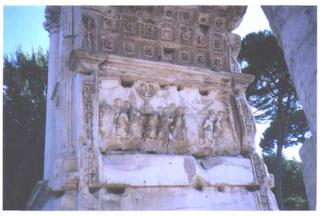INSCRIPTIONS ON THE ARCH OF TITUS שער טיטוס & MORE PHOTOS - Part 2
The coins too demonstrate the importance of this victory. They carry the inscriptions Judea Capta, Judea Devicta, or simply Judea, etc. Bear in mind that in Latin inscriptions, Judea was written IVDAEA. This name was applied by Greeks and Romans to the country that the Jews have traditionally called Land of Israel (also appearing in the New Testament Book of Matthew, 2:20-21). The Greek Ioudaia and the Latin IVDAEA derive from the Aramaic word Yehudaya [= "the Jews"]. Maybe a Greek traveler touring the region of Syria, Lebanon, and Israel, asked a speaker of Aramaic, "Who lives over there?" And the answer was: Yehudaya (the Jews). An H sound in the middle of a word very easily drops out, in English too, and that is likely how the word changed from Yehudaya to Ioudaia. As to the coins, bear in mind that there were several coin issues commemorating this victory and that they were issued over a period of twenty-five [25] years.
The arch and the coins together attest to the antiquity of Jewish history back to the time of the Roman Empire, as well to the destruction of the Temple by Roman forces. They are a concrete refutation of the claims not only of "leftist" historians trying to belittle Jewish history, but of Arab and other pro-PLO historians who nowadays try to deny Jewish history in the Land of Israel altogether. This revolt was only the first of three major Jewish revolts against Rome. The second one occurred in the Diaspora, especially Egypt, in the years 115-117 CE, while the third began in 132 CE. This third revolt, led by Bar Kokhba, lasted four years until 135 CE. This war cost the Romans dearly took, since the Jews wiped out at least one full legion, and the Roman emperor had to replace the commander on the ground with another commander --Julius Severus-- called to Judea from far away Britain.
The Romans continued to call Israel PROVINCIA IVDAEA until they had defeated the Jews in the war [135 CE]. The war is described in earlier posts on this blog concerning its conduct and results [search for Bar Kokhba, Eusebios, Fronto, Dio Cassius, etc.]. Besides massive killing of Jews by Roman legionaries, another result, meant as an insult, punishment and humiliation for the Jews, was the name change from Judea to Provincia Syria Palaestina [apparently carried out in 135 CE].
VIEWS OF THE INNER FACES with bas reliefs, of the ARCH of TITUS

The inner face on the south side seen from the north. The trees in the background are on the Palatine Hill. Note the famous image of the Menorah looted from the Temple in Jerusalem, here being carried in a Roman victory procession. Click on photo to enlarge. The inner face on the north side seen from the south. The arch is located in the main Roman forum. On this relief, we see "the emperor Titus in a triumphal quadriga, driven by the goddess Roma while Victory holds a crown over his head." [Joseph Fattorusso, ed., Wonders of Italy (in the Medici Art Series), (Florence: repr. ed. December 1944); p 399] Click on photo to enlarge.
The inner face on the north side seen from the south. The arch is located in the main Roman forum. On this relief, we see "the emperor Titus in a triumphal quadriga, driven by the goddess Roma while Victory holds a crown over his head." [Joseph Fattorusso, ed., Wonders of Italy (in the Medici Art Series), (Florence: repr. ed. December 1944); p 399] Click on photo to enlarge.
The inscription below appears above the arch on the outer face on the east side facing east.
SENATVS POPULVSQVE ROMANVS
DIVO TITO DIVI VESPANIF
VESPASIANOAVGVSTO
The name Titus appears here in the form of TITO. Note that the emperor still acted in the name of the Senate, referred to here as The Roman Senate and People in the top line of the inscription. This term is often shortened to SPQR.
The inscription below appears on the west side facing west above the arch. It is not original but was engraved by Pope Pius VII who presided as pope from 1800 to 1823. The original inscription had apparently been destroyed in warfare or defaced or damaged in some way. The pope's inscription replaced the original.
Insigne religionis atque artis monumentum
vetustatque Fatiscens
Pius Septimus Pontifex max
Novis Operibus Priscum exemplar imitantibus
Fulciri Servanque ivssit
anno sacri Principatus Eius XXIIII
[minor corrections of some dates made on 11-13-05]
- - - - - - -
Coming soon: A Roman military diploma showing the Roman official usage of the name Judea.
Labels: Arch of Titus, Great Revolt against Rome, Judea, Menorah, Rome





